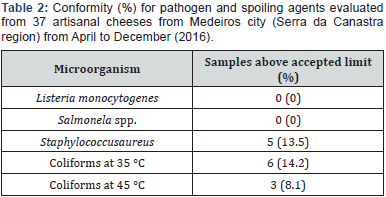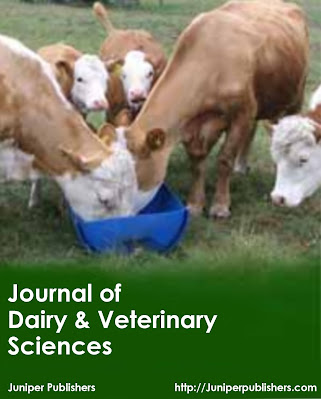Microbiological Quality of Minas Artisanal Cheeses from Certified Properties at Serra da Canastra Region, Minas Gerais, Brazil in 2016-Juniper Publishers
JUNIPER PUBLISHERS-OPEN ACCESS JOURNAL OF DAIRY & VETERINARY SCIENCES
Abstract
The aim of this study was to evaluate the conformity of minas artisanal cheese from certified properties of Medeiros city (Serra da Canastra region), from Minas Gerais state (Brazil), along the year of 2016. Most of the samples (approximately 75%) presented permitted levels of pathogens or spoiling agents (coliforms at 30 and 45°C, Listeria monocytogenes, Salmonella spp., and Staphylococcus aureus). Results show that there are still improvement to make but also show that the pressure from consumers, as well as from state agencies, for a cheese with better quality are starting to make a difference, since the results here presented are better than the latter results from older and similar studies.
Keywords: Microbiological; Maturation period; Tuberculosis; Brucellosis; Ripening periods; Lactic acid; Raw milk; Monocytogenes; Salmonella; Cheeses; Potabilty; Dairy farms; Fermentation; Lactose; Legislation; Coli forms.
Introduction
Minas Gerais State is the largest cheese producer in Brazil. Artisanal production of cheese made from raw milk, initially had a minimal ripening period of 60 days [1]. With the popularization of artisanal cheese, especially the ones from Serra da Canastra region, the state of Minas Gerais defined specific legislations in order to standardize the microbiological quality of these cheeses [2,3]. The main goal of these specific laws was to reduce the ripening period, since 60 days of maturation resulted in cheeses that did not attend to the sensorial profile which costumers of artisanal cheeses were used to. So, federal legislation determined that scientific studies were needed to determine which was the minimal maturation period of each cheese producing region [4]. State legislation accepted some of the studies rigorously produced and determined, for Serra da Canastra region, the minimal period of 22 days of ripening [5]. It is important to report that, among minimal ripening periods and microbiological qualities, other important characteristics were imposed by state and federal legislations, such as herd sanity (mandatory absence of tuberculosis and brucellosis, for e.g.) and good manufacturing practices (implementation of water potabilty, for e.g.).
Materials and Methods
The agriculture institute from the State of Minas Gerais, located at Bambuí, analysed artisanal cheese from certified properties in order to evaluate if the maturation period of 22 days required at one of the main cities of the Serra da Canastra region (Medeiros) were enough to maintain cheese microbiological standard. Certified properties are the ones that attend all proper agricultural and manufacturer practices and are closely inspected by state organs, since they are only ones that can sell artisanal cheese to other Brazilian states [6].
In the year of 2016, 37 artisanal cheeses were analysed from certified properties at the region of Medeiros city. Samples were tested for coliforms that grow at 30 or 45 °C, Staphylococcus aureus, Listeria monocytogenes and Salmonella spp. Permitted microbiological standards are shown at (Table 1).
Results
From April to December (2016), five (13.5%) of the 37 cheese samples analysed presented counts of S. aureus above the limit allowed by state legislation (Table 1). Table 2 also shows that six (14.2%) cheese samples were above the permitted limits for coli forms at 30°C, as well as three (8.1%) of them for coli forms at 45°C. Fortunately, none of the 37 tested cheeses presented L. monocytogenes or any type of Salmonella.


Discussion
Most of the undesirable microorganisms found come from poor hygiene of the utensils used in milking and/or cheesemaking. Dores et al. [7] showed that 22 days of ripening are sufficient to eliminate S. aureus from artisanal cheeses from Serra da Caanstra region. The reduction observed in this study shows the confirmation of this scenario, in which cheese makers are improving their processes, demonstrating that they are gaining conscience of the importance of a clean and hygienic process. S. aureus commonly come either from cheese makers or from mastitis cows, as discussed by Lim et al. [8], who found high percentages of S. aureus (including antibiotic resistant strains) in all environments, workers and animals from dairy farms.
Regarding Salmonella spp. and Listeria monocytogenes, which are the most concerning pathogenic agents involved in food poisoning [9]. In that manner, it is interesting to notice the absence of these concerning pathogens in artisanal cheeses. Martins et al. [10] observed that 22 days of ripening are sufficient to inhibit these genera of microorganisms. These authors attributed the reduction of undesirable microorganisms along ripening to the reduction of pH (mainly due to organic acid production by lactic acid bacteria from raw milk) and to the reduction of humidity that naturally occurs, reducing water activity (Aw) and consequently the conditions that allows microorganism to multiply.
Coliforms are especially associated with early swelling of cheese (caused by gas production through fermentation of lactose), compromising its quality and making its sale unfeasible. Castro et al. [11] observed, as it was observed in this research, that the presence of this group of microorganisms are usually related to rainy seasons (represented by the months of December and January in Minas Gerais). This is due to the mud formed that carries more coliforms via cheese makers clothing and/or cows udder.
Conclusion
Artisanal cheeses from certified properties located at Serra da Canastra region, from Medeiros city, showed, throughout the year of 2016, a reasonable microbiological quality. The results show that there are still some improvements to make but also show that the market pressures, as well as pressure from state agencies, for a cheese with better quality are starting to make a difference, since the results here presented are better than the latter results from older and similar studies.
Conflict of interest
The authors declare that they have no competing interests.
Acknowledgment
We thank Instituto Mineiro de Agropecuária (IMA) for providing the data that made this study possible.
For more Open Access Journals in Juniper Publishers please click on: https://juniperpublishers.com/open-access.php
For more articles in Open Access Journal of Dairy & Veterinary sciences please click on: https://juniperpublishers.com/jdvs/index.php



Comments
Post a Comment